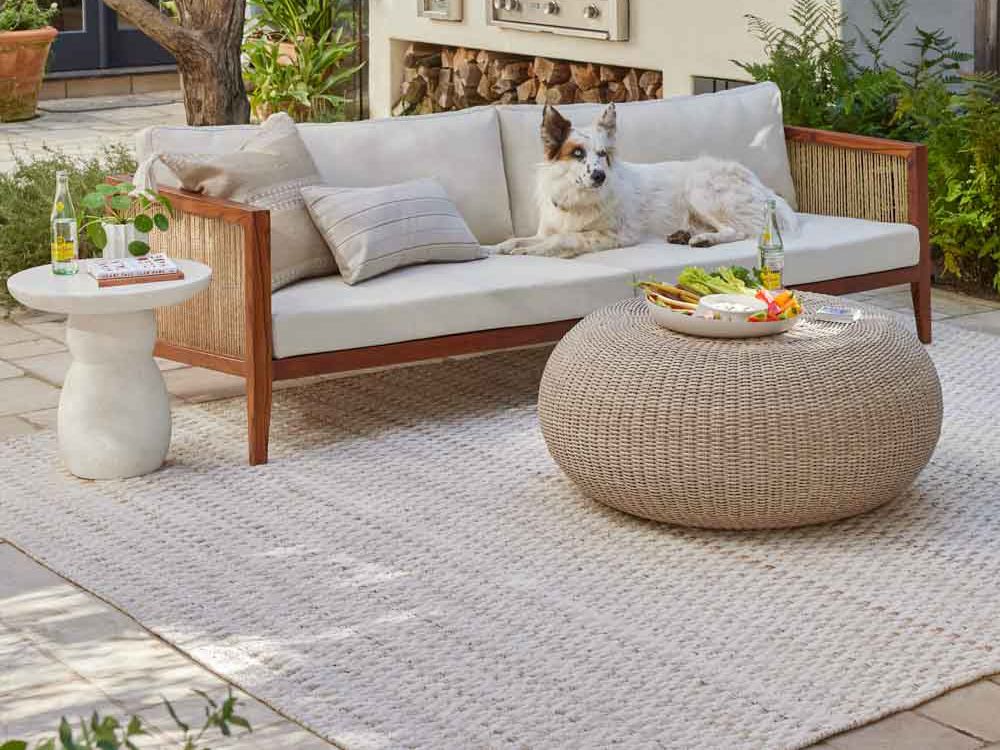What is an outdoor rug?
An outdoor rug is a versatile, all-weather flooring option that helps add texture, color, and comfort to your outdoor living space. These rugs are designed to withstand harsh weather conditions, excess moisture, and mold growth, making them an excellent choice for decking, patios, and other uncovered outdoor spaces.
They come in a variety of materials, including natural fibers like jute and sisal, synthetic fibers like polypropylene, and organic materials like bamboo and cotton. Investing in an outdoor rug can help layer protection on top of your patio, deck or other outdoor floors, while creating a warm and inviting space. In the following section, we will explore the advantages of using outdoor rugs for your outdoor living area.
The Advantages of Outdoor Rugs
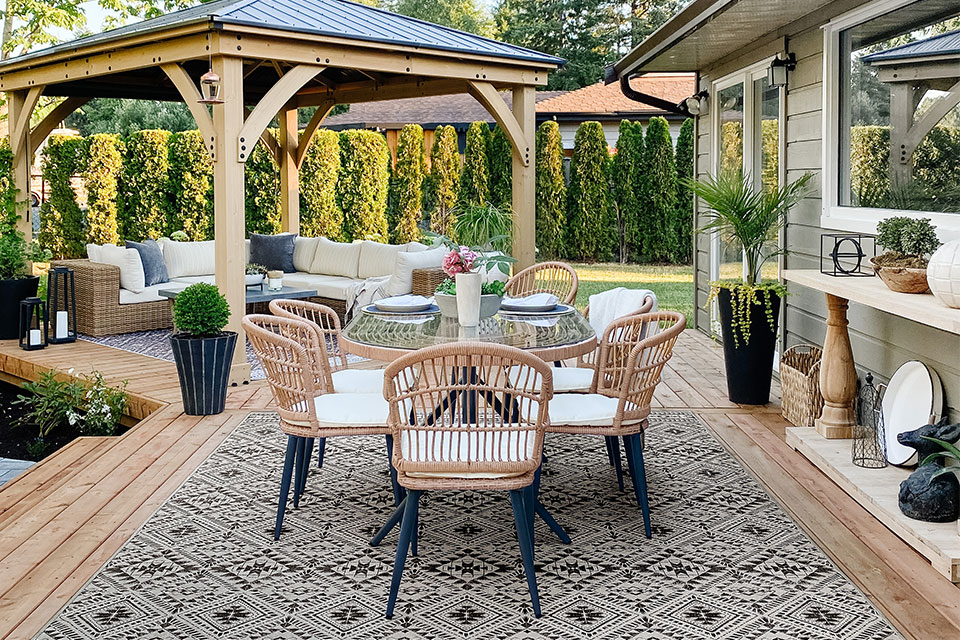
Using outdoor rugs on your patio or deck can provide a plethora of benefits. Not only do they add a layer of protection to your outdoor living space, but they also offer a touch of decor and comfort to your area.
One significant advantage of outdoor rugs is their ability to protect decks or other outdoor surfaces from harsh weather conditions. Whether it’s extreme heat, cold, rain, or snow, outdoor rugs can shield your deck from the elements and extend its life. By acting as a layer of protection, outdoor rugs can prevent any potential damage that harsh weather conditions may cause.
Another benefit of using outdoor rugs is their ability to protect your decks from excess moisture and water damage. They can prevent water from pooling and penetrating decks or other outdoor surfaces, causing rot and other types of damage. By using appropriate materials such as synthetic fibers or natural fibers like jute, sisal, or bamboo, you can ensure that your outdoor rugs can withstand humidity and moisture, and still maintain their quality over time.
Outdoor rugs also provide an opportunity to introduce texture and create a warm ambiance to your wooden decks. With a wide selection of materials available, you can choose from soft fibers, rugged textures, and even patterns to complement your outdoor furniture. The added texture not only enhances the look of your deck but it can also make it safer by providing extra traction for high-traffic areas.
In summary, outdoor rugs are an excellent choice for outdoor living areas due to their protective capabilities, moisture resistance, and versatility in introducing texture. By providing an additional layer of protection against harsh weather conditions and moisture damage, outdoor rugs can extend the life of your deck while enhancing the overall atmosphere of your outdoor space.
Do Outdoor Rugs Ruin Patios?
Outdoor rugs are a popular choice for decorating and providing comfort to outdoor living spaces. However, some homeowners hesitate to use them due to concerns about potential damage to their patios or decks.
In this article, we’ll examine some of the most common questions regarding outdoor rugs, including their effects on wood and composite decks, the risk of mildew and mold growth, whether rug materials are suitable for use on concrete surfaces, the possibility of excess moisture or water damage, and how harsh weather conditions might impact outdoor rugs over time.
Can Outdoor Rugs Damage Wood Decks and Composite Decks?
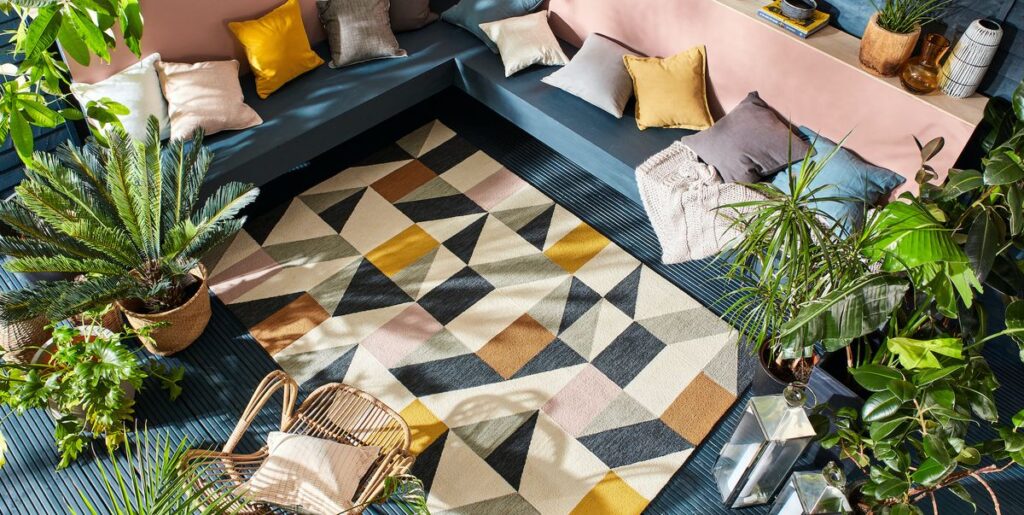
Outdoor rugs, despite their potential usefulness, can cause damages on both wooden and composite decks. The damages incurred are dependent on varying factors such as the type of rug used, maintenance levels, and the type of material used in constructing the decks.
Wooden decks are particularly vulnerable to damages caused by outdoor rugs. When outdoor rugs are used on wooden decks, they can trap moisture underneath, create damp, and encourage the growth of mildew and mold, causing long-term damage to the wooden deck surface. Furthermore, the colors from the rug can spread into the wood and become more permanent over time, which can cause damage to the deck’s surface.
Composite decks, while considered to be more resilient than wooden decks, can also be damaged by the use of outdoor rugs. Since composite decks are usually made of synthetic materials, they are more susceptible to scratches, and outdoor rugs can cause scratches that may result in costly repairs. This is particularly the case when the rug materials are rough and abrasive.
It is important to note that the level of damage caused by outdoor rugs depends on the type of rug used and how well it is maintained. Synthetic rugs with tightly woven polypropylene material and recycled plastic mats, for instance, tend to trap less moisture than natural fiber rugs, which can help reduce the risk of mildew growth and water damage. Furthermore, they are more durable and can prevent damage to the deck surface, thus providing an additional layer of protection.
In summary, the use of outdoor rugs on wooden decks and composite decks can cause damages that could be costly to repair. However, with appropriate maintenance and the use of synthetic rugs, potential damages can be greatly reduced.
Does Mildew Growth Occur on Outdoor Rugs?

Outdoor rugs can be a great addition to any outdoor living space, but if not properly maintained, they can become a breeding ground for unsightly mildew growth. Mildew can accumulate on outdoor rugs due to excess moisture, which can occur during periods of high humidity or rainy weather.
To prevent mildew growth on outdoor rugs, regular cleaning is key. Thoroughly vacuuming the rug will remove any dust and debris that may have settled on it. After vacuuming, it is important to thoroughly air-dry the rug before putting it back in its place. If the rug is left out in the sun for a few hours, the UV rays will help dry it out.
Protective measures can also be taken to maintain outdoor rugs and prevent mildew growth. For instance, using rug pads can help prevent moisture from accumulating underneath the rug. Additionally, washing the rug with a vinegar-water mixture can help remove any existing mildew and prevent new mildew from forming. It is important to follow the manufacturer’s instructions for cleaning, as well as testing a small section of the rug’s corner before using bleach to remove mildew. This will help prevent any unwanted color damage that bleach may cause.
In summary, preventing mildew growth on outdoor rugs requires regular cleaning and thorough air-drying to prevent moisture build-up. Additionally, using protective measures such as rug pads and washing with a vinegar-water mixture can help maintain the rug and prevent mildew growth. It is always important to follow the manufacturer’s instructions and test a small section before using bleach to remove mildew.
Are Rug Materials Suitable for Use on Concrete Surfaces?
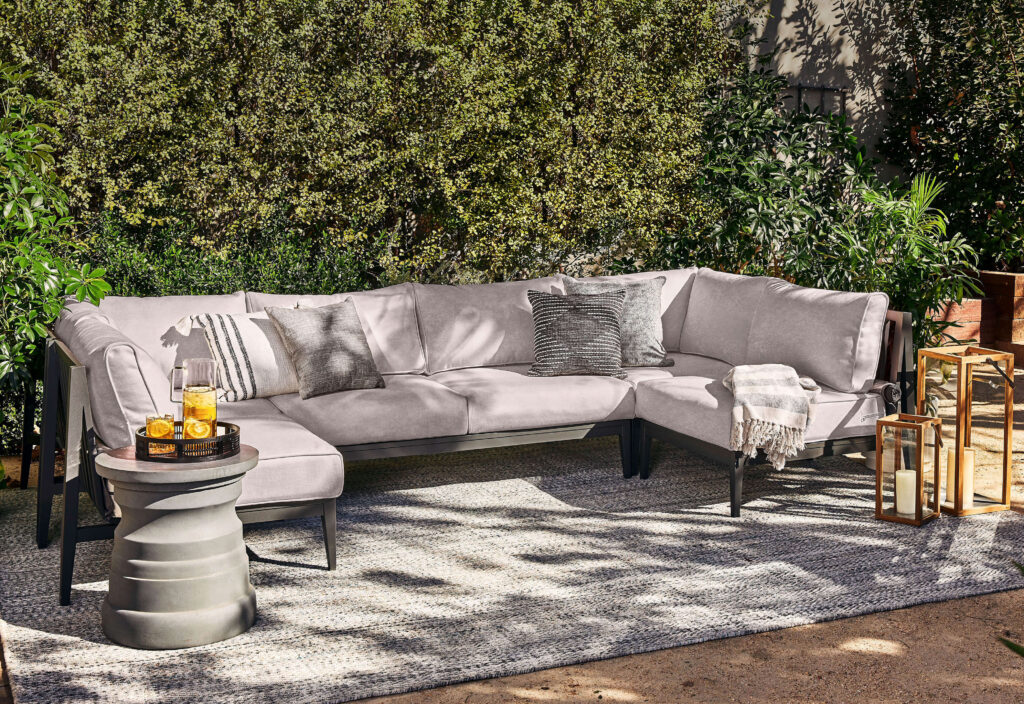
If you have an outdoor living space made of concrete, adding a rug can easily enhance its appearance, functionality, and of course, comfort. However, not all rug materials are created equal when it comes to concrete surfaces. Here are some rug materials that are suitable for use on concrete surfaces, along with their benefits:
1. Natural fibers
Natural fiber rugs, such as bamboo and jute, provide a sustainable and soft option for concrete surfaces. They are lightweight, eco-friendly, and visually appealing. Natural fibers also allow better air circulation, which can prevent the accumulation of moisture and mildew. However, they may not be as durable as synthetic rugs and may require more maintenance.
2. Synthetic fabrics
Synthetic fabrics such as nylon, acrylic, polyester, and polypropylene are water and stain-resistant, fade less easily, and can handle heavy foot traffic. These materials are great for outdoor use since they can withstand harsh weather conditions. Synthetic fabrics also dry quickly, making them an excellent choice if your concrete surface is prone to excess moisture.
3. Polypropylene outdoor rugs
Polypropylene outdoor rugs are currently the most popular choice among homeowners due to their soft feel, even though they are synthetic. They are lightweight, easy to clean, and resistant to mildew growth. Polypropylene rugs are also durable and can withstand heavy foot traffic, making them an ideal choice for high-traffic areas.
Using a rug on your concrete surface can offer a layer of protection and cover up any damage or discoloration, giving it a fresh new look. Additionally, rugs provide comfort to your feet, making your space feel warmer and more welcoming. Whether you choose natural fibers or synthetic fabrics, make sure to consider their durability, maintenance requirements, and their visual appeal before making your final decision.
Is There a Risk of Excess Moisture or Water Damage with Outdoor Rugs?
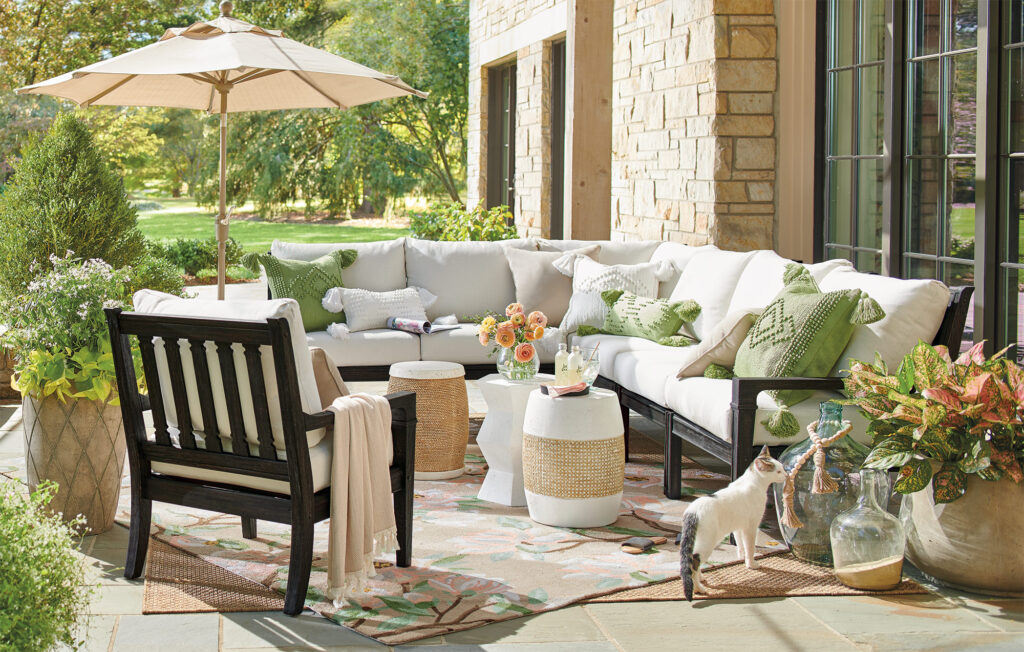
While outdoor rugs can add a cozy element to your outdoor living space, they can also pose a risk for excess moisture and water damage. If your rug is exposed to rain or other sources of moisture and is not allowed to dry properly, it can cause mold and mildew growth or rotting of wooden surfaces. Here are some tips to prevent and address these issues:
1. Allow the rug to dry completely
After exposure to moisture, it’s important to allow your outdoor rug to dry completely before using it again. This can be done by shaking off any excess water, hanging the rug in a well-ventilated area, or using a fan to promote air circulation.
2. Use practical drying methods
If your rug is soaked through, you may need to take more drastic measures to dry it properly. Consider using a wet-dry vacuum to extract excess water, using a steam cleaner to deeply clean and dry the rug, or even laying the rug out in the sun on a warm, dry day.
3. Protect wooden surfaces
If you have a wooden deck or patio, it’s essential to protect it from excess moisture. Consider placing your rug on a non-wooden surface, such as concrete or brick, to prevent water damage and rotting.
By taking these precautions and allowing your outdoor rug to dry completely after exposure to moisture, you can prevent excess moisture and water damage. Remember to protect wooden surfaces and consider non-wooden surfaces for drying outdoor rugs to avoid any potential issues.
Will Mold Growth Occur in High-Traffic Areas with Rug Use?
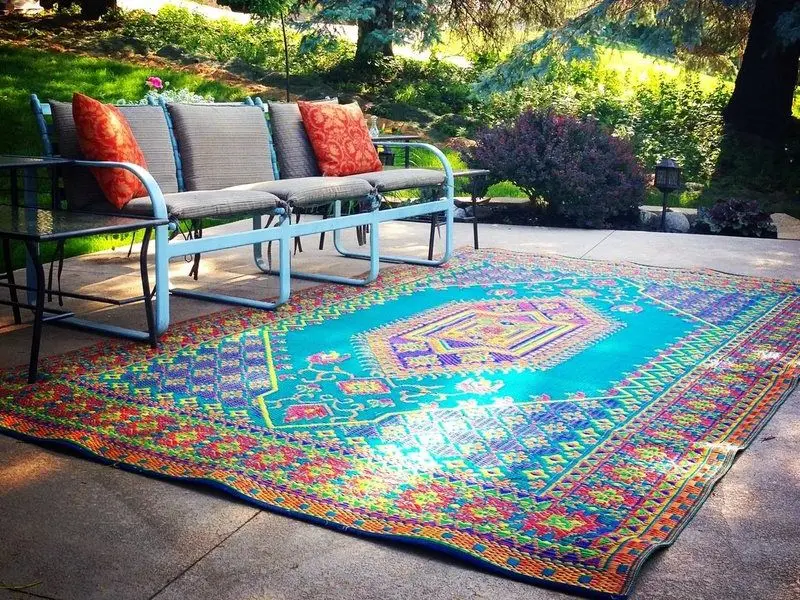
As outdoor rugs are often used in high-traffic areas, it’s important to take extra care to prevent mold growth. Mold can easily grow in areas that are constantly damp, so it’s important to take preventive measures to avoid any potential issues.
One effective way to prevent mold growth in high-traffic areas on outdoor rugs is to ensure that the rug is completely dry before using it again. This is particularly important after exposure to excessive moisture, such as rain or spills. To do this, it’s recommended that you shake off any excess water, hang the rug in a well-ventilated area, or use a fan to speed up the drying process.
Additionally, it’s important to regularly vacuum and clean the rug to remove any dirt or debris that can trap moisture and promote mold growth. Use a rug pad to allow air circulation and avoid trapping moisture under the rug. This can also prevent the rug from sliding around on hard surfaces.
Another preventive measure is to choose a material that is mildew-resistant, such as those made from polypropylene or polyester. These materials are less likely to retain moisture and encourage mold growth, making them an excellent choice for high-traffic areas.
Finally, consider rotating the rug periodically to ensure even wear and to prevent excessive damage to a particular area. By following these preventive measures, you can keep your outdoor rug in excellent condition and prevent mold growth in high-traffic areas.
Will Harsh Weather Conditions Damage the Rug Materials Over Time?

Even though outdoor rugs are made to withstand harsh weather conditions, it’s crucial to take preventive measures to protect the rug materials over time. By doing so, you can extend the life of your outdoor rug and keep it in excellent condition.
One important factor to consider is the material of the rug. To ensure the rug’s longevity, it’s recommended to choose a weather-resistant material with UV protection. This can help prevent any discoloration or damage caused by the sun’s harsh rays. Some of the popular weather-resistant materials include polypropylene and polyester.
Another way to protect your outdoor rug in extreme weather conditions is to store it in a dry area. If you’re expecting heavy rains or snow, make sure to roll up the rug and store it to prevent mildew growth or water damage. This will also prevent any moisture from being trapped under the rug, which can cause damage over time.
Investing in a rug pad can also provide extra protection for your outdoor rug. The rug pad can prevent movement on slick surfaces and provide additional cushioning to prevent wear and tear.
Lastly, it’s important to regularly clean your outdoor rug to remove any dirt or debris that could cause damage over time. Use soapy water and a soft brush to clean the rug and let it dry completely before using it again.
By following these preventive measures, you can protect your outdoor rug from harsh weather conditions and keep it in excellent condition for years to come.
Choosing the Right Outdoor Rug Material
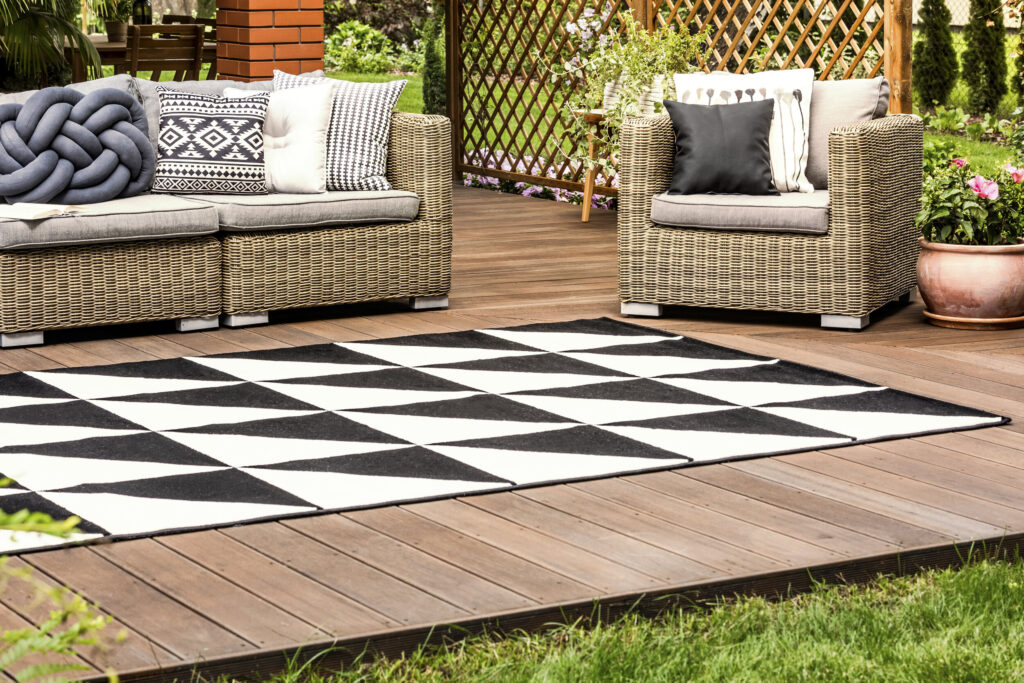
When choosing an outdoor rug, it’s important to consider the materials used in their construction. Natural fibers and synthetic fibers both have their advantages and drawbacks, so it’s important to know the difference between them before making a decision. Durable materials that can withstand harsh conditions and heavy traffic will ensure the longevity of your rug. Organic materials are great for resisting mold and water damage, while synthetic materials require less maintenance. Keep in mind these considerations when selecting an outdoor rug material to make sure you get the perfect rug for your patio space.
Natural Fibers vs Synthetic Fibers: Which is Better for Patio Use?
When it comes to choosing between natural fibers and synthetic fibers for your outdoor patio rug, it’s important to understand the differences between these two materials. Natural fibers such as wool, jute, and sisal, are made from plant or animal sources. These materials are known for their soft texture and earthy tones, making them a popular choice for indoor spaces. However, when it comes to outdoor use, natural fibers can interact with the molecules in wood and can be unsuitable for high humidity settings.
On the other hand, synthetic fibers like nylon, polyester, and polypropylene, are man-made materials designed specifically for outdoor use. These materials are durable, resistant to mildew and water damage, and require minimal maintenance. They are an excellent choice for patios and outdoor living spaces, providing an extra layer of protection for your concrete surfaces, wood deck, or composite decking.
When comparing natural fibers to synthetic fibers, durability is often the main factor to consider. Natural fibers are beautiful and can add texture to wood decks, but they tend to wear out faster than synthetic fibers. Synthetic fibers, on the other hand, are more durable and can easily withstand harsh weather conditions and excess moisture. They are also easy to clean and maintain with soapy water and a brush.
The top 5 most relevant keywords for this section are natural fibers, synthetic fibers, durability, resistance to mildew and water damage, and maintenance needs. Ultimately, the decision to choose natural or synthetic fibers for your outdoor rug depends on personal preference and the specific needs of your outdoor space. While natural fibers can be a good choice for a covered patio, synthetic fibers tend to be a better option for uncovered patios or high-traffic areas.
Durable Materials That Can Withstand Harsh Conditions and Heavy Traffic
When it comes to outdoor rugs, durability is one of the most crucial factors. Outdoor rugs need to be able to withstand harsh weather conditions, heavy foot traffic, and exposure to UV rays without fading or becoming damaged. Fortunately, there are several materials that are known for their durability and ability to perform well in extreme outdoor conditions.
Polypropylene is one of the most popular materials for outdoor rugs, thanks to its durable nature. This material is resistant to mold and mildew growth, making it ideal for humid or damp environments. In addition, polypropylene also offers excellent UV protection, ensuring that the rug will not fade or become discolored over time.
Polyester is another material that is frequently used for outdoor rugs. It is durable and can withstand heavy foot traffic, making it a great choice for outdoor living spaces. Polyester rugs are often lightweight and easy to clean, requiring minimal maintenance. In addition, they are also fade-resistant and provide excellent UV protection.
Nylon is a synthetic material that is known for its durability and strength. It is an excellent choice for outdoor rugs as it can handle heavy traffic and harsh weather conditions without showing signs of wear and tear. Nylon rugs are also resistant to mold, mildew, and UV rays, making them ideal for use in areas with high levels of moisture or direct sunlight.
Aside from the material, other features that contribute to a rug’s durability include its thickness, texture, and backing materials. A thicker rug will provide more cushioning and a better feel underfoot, while a textured rug will provide better traction. A rug with a sturdy backing material will also help to prevent slipping and sliding, making it safer for high-traffic areas.
Overall, choosing a durable and long-lasting outdoor rug is essential for any outdoor living space. By selecting a rug made from materials such as polypropylene, polyester, or nylon and paying attention to its thickness, texture, and backing material, you can ensure that your rug will provide excellent performance and longevity, even in extreme outdoor conditions.
Organic Materials That Resist Mildew Growth and Water Damage
When it comes to choosing natural fiber outdoor rugs, there are several organic materials that can resist mildew growth and water damage. Sisal and jute are two excellent choices that offer exceptional durability and naturally resist mildew growth. These fibers can hold mildew, but they won’t become damaged as easily as other organic options. Sisal and jute rugs are a great choice for high-traffic areas, as they can withstand a lot of wear and tear without showing signs of damage.
Seagrass and hemp rugs are also natural fiber options that provide excellent resistance to water damage. Seagrass rugs are woven from natural seaweed fibers, which allow them to be water-resistant. Hemp is another natural fiber that is known for its water-resistant properties, making it an excellent choice for damp or humid outdoor spaces. These organic rugs can also be great eco-friendly additions to your outdoor decor, adding warmth and texture to your outdoor space while promoting sustainability.
Choosing organic materials for outdoor rugs is a great way to make your outdoor space more inviting and eco-friendly. Sisal, jute, seagrass, and hemp rugs are all natural fiber options that provide resistance to mildew growth and water damage, making them an excellent choice for outdoor areas that are exposed to humidity or moisture. These rugs are also highly durable and can withstand heavy foot traffic, making them an ideal choice for outdoor spaces that see a lot of activity.
Synthetic Materials That Require Less Maintenance Than Natural Fibers
While natural fiber rugs may look beautiful, they require more maintenance compared to their synthetic counterparts. That’s why synthetic materials are an excellent choice for those looking to spend less time maintaining their outdoor rugs. Synthetic materials for outdoor rugs are resistant to moisture and mildew, making them ideal for patios and decks exposed to harsh weather.
Synthetic materials are also highly durable and can withstand heavy foot traffic without showing signs of damage. This makes them an excellent choice for high-traffic areas and uncovered patios. Additionally, synthetic materials for outdoor rugs are available in a variety of colors and styles, so you can find the perfect match for your outdoor living space.
Some popular synthetic materials for outdoor rugs include polypropylene, nylon, and polyester. Polypropylene is a popular choice for decking because it is mildew-resistant, easy to clean, and can withstand UV rays. Nylon is another popular choice for outdoor rugs because of its durability and natural resistance to mildew and moisture. Polyester is ideal for outdoor spaces because it is soft to the touch and resistant to fading.
When creating content for your synthetic outdoor rug, be sure to include keywords that will attract your target audience. Keywords such as synthetic materials, less maintenance, moisture-resistant, mildew-resistant, and durability are all essential for reaching people searching for outdoor rugs that require less maintenance. With synthetic materials and the right keywords, you can create a beautiful and low-maintenance outdoor living space that you can enjoy for years to come.
Considerations When Selecting an Outdoor Rug Material
When selecting an outdoor rug material, there are several considerations to keep in mind, including the durability and resistance of the rug to wear, sun fading, and water damage. There are two primary types of rug materials for outdoor use: natural fibers and synthetic fibers.
Natural fiber rugs, such as those made from jute or sisal, are known for their earthy and organic appearance. However, they generally require more maintenance than synthetic fibers and are less durable. Natural fiber rugs are prone to mold and mildew growth in damp and humid climates, and they can also fade if exposed to direct sunlight for extended periods.
On the other hand, synthetic fiber rugs are highly durable and can withstand harsh weather conditions, heavy foot traffic, and excess moisture without showing signs of wear. They are also resistant to fading and sun damage, making them perfect for outdoor use. Some popular synthetic rug materials include nylon, acrylic, polyester, and polypropylene. Nylon is one of the most durable synthetic outdoor rug materials, and its natural resistance to mold and mildew makes it a great choice for humid or rainy climates.
Acrylic is another popular choice because of its resistance to sun and water damage, but it does tend to be more expensive than other synthetic fibers. Polyester is a cost-effective option and is soft to the touch, but it can be less durable than other materials in high-traffic areas. Polypropylene is commonly used on decks and patios as it is mildew-resistant, easy to clean, and it can withstand UV rays without fading.
When selecting the best outdoor rug material, it is important to consider the following factors: the cost, the climate, and the intended use. Natural fiber rugs may require more maintenance and are less durable, but they may be the perfect choice for a covered patio or a space that does not experience heavy foot traffic.
Synthetic fiber rugs are ideal for high-traffic areas and uncovered patios that are exposed to harsh weather conditions. Nylon is the most durable material for humid or rainy climates while polypropylene is the perfect fit for uncovered outdoor spaces that are exposed to UV rays.
In conclusion, when choosing an outdoor rug material, be sure to keep the climate and intended use in mind. The durability and resistance of the rug to wear, sun fading, and water damage should also be taken into consideration. With the right material and a focus on durability and resistance, you can create an outdoor living space that is both beautiful and functional.

